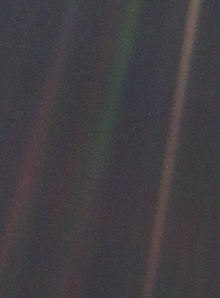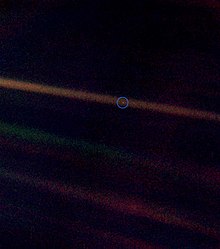Pale Blue Dot

The Pale Blue Dot is a photograph of planet Earth taken in 1990 by Voyager 1 from a record distance, showing it against the vastness of space. The idea for taking the distant photo and the title came from scientist and astronomer Carl Sagan, who also wrote the 1994 book of the same name.[1] In 2001, it was selected by Space.com as one of the top ten space science photos.[2]
Photograph
Voyager 1 was launched on September 5, 1977. Sagan had pushed for Voyager to take a photo of the Earth when its vantage point reached the edge of the solar system.[3][4][5] [6] On February 14, 1990, having completed its primary mission, NASA commanded the spacecraft to turn around to photograph the planets of the Solar System.[7][8][5][6] Between February 14, 1990 and June 6, 1990, one image Voyager returned was of Earth, showing up as a "pale blue dot" in the grainy photo.[3][9] [10]

Sagan gives the distance as 3.7 billion miles (6 billion kilometres) in his book. According to NASA's Jet Propulsion Laboratory HORIZONS software system,[11] the following table displays the distances calculated from Voyager to the Earth on the dates indicated.
| Unit of Measurement | February 14, 1990 | June 9, 1990 |
|---|---|---|
| Astronomical Units | 40.4722269111071 | 40.6835761263791 |
| Converted to Kilometres | 6,054,558,968.024 | 6,086,176,360.601 |
| Converted to Miles | 3,762,136,324.748 | 3,781,782,502.403 |
The picture was taken using a narrow-angle camera at 32° above the ecliptic, and created using blue, green, and violet filters.[12] Narrow-angle cameras, as opposed to wide-angle cameras, are equipped to photograph specific details in an area of interest.[13] The light band over Earth is an artifact of sunlight scattering in the camera's optics, resulting from the small angle between Earth and the Sun.[9][6] Earth takes up less than a single pixel — NASA says "only 0.12 pixel in size."[12]

Voyager took similar pictures of Venus, Jupiter, Saturn, Uranus and Neptune, creating a portrait of the Solar System.[12] Mercury's proximity to the Sun prevented it from being photographed and Mars was not visible due to the effect of sunlight on the camera's optics.[14] NASA compiled 60 images produced into a mosaic, called the Family Portrait.
Reflections by Sagan
In a commencement address delivered May 11, 1996, Sagan related his thoughts on the deeper meaning of the photograph:[15][5]
Look again at that dot. That's here. That's home. That's us. On it everyone you love, everyone you know, everyone you ever heard of, every human being who ever was, lived out their lives. The aggregate of our joy and suffering, thousands of confident religions, ideologies, and economic doctrines, every hunter and forager, every hero and coward, every creator and destroyer of civilization, every king and peasant, every young couple in love, every mother and father, hopeful child, inventor and explorer, every teacher of morals, every corrupt politician, every "superstar," every "supreme leader," every saint and sinner in the history of our species lived there – on a mote of dust suspended in a sunbeam.
The Earth is a very small stage in a vast cosmic arena. Think of the rivers of blood spilled by all those generals and emperors so that, in glory and triumph, they could become the momentary masters of a fraction of a dot. Think of the endless cruelties visited by the inhabitants of one corner of this pixel on the scarcely distinguishable inhabitants of some other corner, how frequent their misunderstandings, how eager they are to kill one another, how fervent their hatreds.
Our posturings, our imagined self-importance, the delusion that we have some privileged position in the Universe, are challenged by this point of pale light. Our planet is a lonely speck in the great enveloping cosmic dark. In our obscurity, in all this vastness, there is no hint that help will come from elsewhere to save us from ourselves.
The Earth is the only world known so far to harbor life. There is nowhere else, at least in the near future, to which our species could migrate. Visit, yes. Settle, not yet. Like it or not, for the moment the Earth is where we make our stand.
It has been said that astronomy is a humbling and character-building experience. There is perhaps no better demonstration of the folly of human conceits than this distant image of our tiny world. To me, it underscores our responsibility to deal more kindly with one another, and to preserve and cherish the pale blue dot, the only home we've ever known.
Use in media

Al Gore's 2006 documentary film An Inconvenient Truth featured the "Pale Blue Dot" photo at the end. Gore used it in a slide show to underline his belief that global warming is a serious problem,[16] paraphrasing Carl Sagan with the statement, "That's all we've got".
See also
- Space and survival
- Earthrise
- Earth's location in the universe
- The Blue Marble
- Family Portrait (Voyager)
References
- ^
Sagan, Carl (1994). Pale Blue Dot: A Vision of the Human Future in Space (1st edition ed.). New York: Random House. ISBN 0-679-43841-6.
{{cite book}}:|edition=has extra text (help) - ^ Britt, Robert Roy (25 September 2001). "Experts Pick: Top 10 Space Science Photos". Space.com.
- ^ a b Sagan. "Chapter 1. You Are Here". Pale Blue Dot. The quote is much copied elsewhere on the web.
- ^ Sagan, Carl (2000). Carl Sagan's Cosmic Connection: An Extraterrestrial Perspective. Cambridge University Press. p. XV. ISBN 0521783038, 9780521783033.
{{cite book}}: Check|isbn=value: invalid character (help); More than one of|pages=and|page=specified (help); Unknown parameter|coauthors=ignored (|author=suggested) (help) - ^ a b c Bennett, Jeffrey O. (2008). Beyond UFOs: The Search for Extraterrestrial Life and Its Astonishing Implications for Our Future. Princeton University Press. p. 181-183. ISBN 691135495, 9780691135496.
{{cite book}}: Check|isbn=value: invalid character (help); More than one of|pages=and|page=specified (help) - ^ a b c Von Baeyer, Hans Christian (2000). Taming the Atom: The Emergence of the Visible Microworld. Courier Dover Publications. p. Xxi. ISBN 0486414477, 9780486414478.
{{cite book}}: Check|isbn=value: invalid character (help); More than one of|pages=and|page=specified (help) - ^ "Pale Blue Dot". The Planetary Society. Retrieved 2006-07-27.
- ^ Cockell, Charles (2003). Impossible Extinction: Natural Catastrophes and the Supremacy of the Microbial World. Cambridge University Press. p. 24. ISBN 0521817366, 9780521817363.
{{cite book}}: Check|isbn=value: invalid character (help); More than one of|pages=and|page=specified (help) - ^ a b Gonzalez, Guillermo (2004). The Privileged Planet: How Our Place in the Cosmos is Designed for Discovery. Regnery Publishing. p. X,224. ISBN 0895260654, 9780895260659.
{{cite book}}: Check|isbn=value: invalid character (help); More than one of|pages=and|page=specified (help); Unknown parameter|coauthors=ignored (|author=suggested) (help) - ^ Visible Earth: A catalog of NASA images and animations of our home planet. Retrieved 2009-02-28
- ^ NASA's JPL Horizon System for calculating ephemerides for solar system bodies
- ^ a b c "Solar System Portrait – Earth as 'Pale Blue Dot'". NASA. Cite error: The named reference "VisibleEarth" was defined multiple times with different content (see the help page).
- ^ "SPACECRAFT - Cassini Orbiter Instruments - ISS". NASA.
- ^ "Solar System Portrait – Views of 6 Planets". NASA.
- ^ "Reflections on a Mote of Dust". Retrieved 2007-04-07.
- ^ Gore, Al (January 15, 2004). "Al Gore Speaks on Global Warming and the Environment". MoveOn.org. Retrieved 2006-12-18.
External links
- Sagan's rationale for human spaceflight Article about Carl Sagan and Pale Blue Dot
- Spaceflight or Extinction: Carl Sagan Excerpts from Pale Blue Dot
- A new picture of Earth taken through the rings of Saturn by the Cassini spacecraft on September 15, 2006. Cassini's most popular photo.
- Carolyn Porco's opening speech on Pangea Day, May 10, 2008 Carolyn Porco discusses Cassini's image of Earth and introduces a film based on Sagan's 'Pale Blue Dot' on Pangea Day
- BookTalk.org: discuss Carl Sagan's Pale Blue Dot with other readers
- Carl Sagan's Pale Blue Dot: A Greener, Less Anthropocentric Envisioning on YouTube - A short film narrated by Carl Sagan (40 min extended version)
- We Are Here: The Pale Blue Dot on YouTube — a film by David Fu
- JPL's HORIZONS - on-line solar system data and ephemeris computation service
